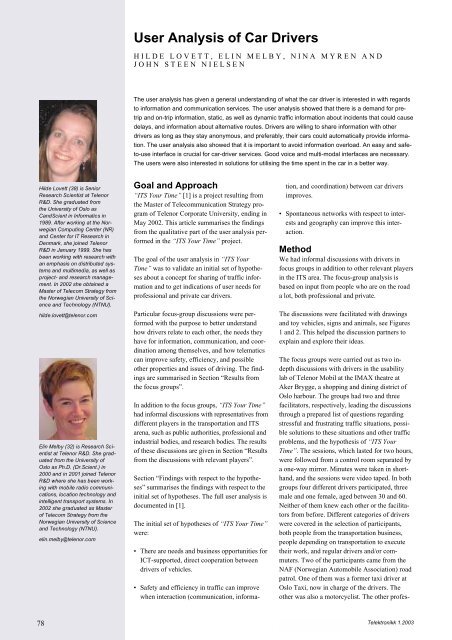Intelligent Transport Systems - Telenor
Intelligent Transport Systems - Telenor
Intelligent Transport Systems - Telenor
Create successful ePaper yourself
Turn your PDF publications into a flip-book with our unique Google optimized e-Paper software.
Hilde Lovett (38) is Senior<br />
Research Scientist at <strong>Telenor</strong><br />
R&D. She graduated from<br />
the University of Oslo as<br />
CandScient in Informatics in<br />
1989. After working at the Norwegian<br />
Computing Center (NR)<br />
and Center for IT Research in<br />
Denmark, she joined <strong>Telenor</strong><br />
R&D in January 1999. She has<br />
been working with research with<br />
an emphasis on distributed systems<br />
and multimedia, as well as<br />
project- and research management.<br />
In 2002 she obtained a<br />
Master of Telecom Strategy from<br />
the Norwegian University of Science<br />
and Technology (NTNU).<br />
hilde.lovett@telenor.com<br />
Elin Melby (32) is Research Scientist<br />
at <strong>Telenor</strong> R&D. She graduated<br />
from the University of<br />
Oslo as Ph.D. (Dr.Scient.) in<br />
2000 and in 2001 joined <strong>Telenor</strong><br />
R&D where she has been working<br />
with mobile radio communications,<br />
location technology and<br />
intelligent transport systems. In<br />
2002 she graduated as Master<br />
of Telecom Strategy from the<br />
Norwegian University of Science<br />
and Technology (NTNU).<br />
elin.melby@telenor.com<br />
78<br />
User Analysis of Car Drivers<br />
HILDE LOVETT, ELIN MELBY, NINA MYREN AND<br />
JOHN STEEN NIELSEN<br />
The user analysis has given a general understanding of what the car driver is interested in with regards<br />
to information and communication services. The user analysis showed that there is a demand for pretrip<br />
and on-trip information, static, as well as dynamic traffic information about incidents that could cause<br />
delays, and information about alternative routes. Drivers are willing to share information with other<br />
drivers as long as they stay anonymous, and preferably, their cars could automatically provide information.<br />
The user analysis also showed that it is important to avoid information overload. An easy and safeto-use<br />
interface is crucial for car-driver services. Good voice and multi-modal interfaces are necessary.<br />
The users were also interested in solutions for utilising the time spent in the car in a better way.<br />
Goal and Approach<br />
“ITS Your Time” [1] is a project resulting from<br />
the Master of Telecommunication Strategy program<br />
of <strong>Telenor</strong> Corporate University, ending in<br />
May 2002. This article summarises the findings<br />
from the qualitative part of the user analysis performed<br />
in the “ITS Your Time” project.<br />
The goal of the user analysis in “ITS Your<br />
Time” was to validate an initial set of hypotheses<br />
about a concept for sharing of traffic information<br />
and to get indications of user needs for<br />
professional and private car drivers.<br />
Particular focus-group discussions were performed<br />
with the purpose to better understand<br />
how drivers relate to each other, the needs they<br />
have for information, communication, and coordination<br />
among themselves, and how telematics<br />
can improve safety, efficiency, and possible<br />
other properties and issues of driving. The findings<br />
are summarised in Section “Results from<br />
the focus groups”.<br />
In addition to the focus groups, “ITS Your Time”<br />
had informal discussions with representatives from<br />
different players in the transportation and ITS<br />
arena, such as public authorities, professional and<br />
industrial bodies, and research bodies. The results<br />
of these discussions are given in Section “Results<br />
from the discussions with relevant players”.<br />
Section “Findings with respect to the hypotheses”<br />
summarises the findings with respect to the<br />
initial set of hypotheses. The full user analysis is<br />
documented in [1].<br />
The initial set of hypotheses of “ITS Your Time”<br />
were:<br />
• There are needs and business opportunities for<br />
ICT-supported, direct cooperation between<br />
drivers of vehicles.<br />
• Safety and efficiency in traffic can improve<br />
when interaction (communication, informa-<br />
tion, and coordination) between car drivers<br />
improves.<br />
• Spontaneous networks with respect to interests<br />
and geography can improve this interaction.<br />
Method<br />
We had informal discussions with drivers in<br />
focus groups in addition to other relevant players<br />
in the ITS area. The focus-group analysis is<br />
based on input from people who are on the road<br />
a lot, both professional and private.<br />
The discussions were facilitated with drawings<br />
and toy vehicles, signs and animals, see Figures<br />
1 and 2. This helped the discussion partners to<br />
explain and explore their ideas.<br />
The focus groups were carried out as two indepth<br />
discussions with drivers in the usability<br />
lab of <strong>Telenor</strong> Mobil at the IMAX theatre at<br />
Aker Brygge, a shopping and dining district of<br />
Oslo harbour. The groups had two and three<br />
facilitators, respectively, leading the discussions<br />
through a prepared list of questions regarding<br />
stressful and frustrating traffic situations, possible<br />
solutions to these situations and other traffic<br />
problems, and the hypothesis of “ITS Your<br />
Time”. The sessions, which lasted for two hours,<br />
were followed from a control room separated by<br />
a one-way mirror. Minutes were taken in shorthand,<br />
and the sessions were video taped. In both<br />
groups four different drivers participated, three<br />
male and one female, aged between 30 and 60.<br />
Neither of them knew each other or the facilitators<br />
from before. Different categories of drivers<br />
were covered in the selection of participants,<br />
both people from the transportation business,<br />
people depending on transportation to execute<br />
their work, and regular drivers and/or commuters.<br />
Two of the participants came from the<br />
NAF (Norwegian Automobile Association) road<br />
patrol. One of them was a former taxi driver at<br />
Oslo Taxi, now in charge of the drivers. The<br />
other was also a motorcyclist. The other profes-<br />
Telektronikk 1.2003
















